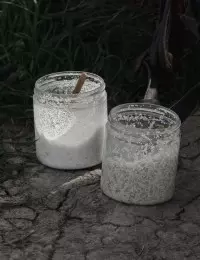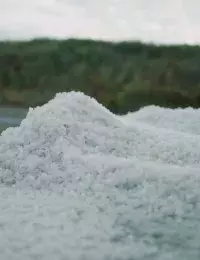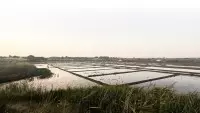
Sea salt: everything you need to know
Over time and the vagaries of climate, the rocks and seabeds that shape the seas and oceans have given them a singular characteristic, thesalt water.
When this water is collected and evaporates, it's possible to collect one of its treasures, its salt: proof of nature's true magic.
Let's dive together into the fascinating world of salt, and more particularly of the most natural of them all: sea salt.
The different types of salt
According to their origin
Salts are generally classified according to their origin, composition and harvesting technique, or extraction process.
To better understand their differences:
- Natural salt is unrefined salt: not chemically treated. It is totally natural, gray and still has all its natural benefits. Natural salt comes from sea water and is produced in many different regions. It therefore changes in appearance and taste depending on where it comes from and its mineral concentration.
- Refined salt is salt produced from salt deposits that have been chemically treated to purify and whiten it, so that it can be better preserved. All its minerals have been removed, and it contains almost nothing but sodium chloride. Refined salts are widely used in the chemical and food industries.
- Sea salt: naturally grey sea salt is a natural salt extracted in a sustainable and environmentally-friendly way in seawater harvesting basins, where it then evaporates. The salt is then harvested by hand.
- Table salt: table salt, also known as food salt or cooking salt, is a salt essentially composed of sodium chloride. It is a refined salt used mainly as a condiment in cooking.
Le Guérandais Guérande salt
Le Guérandais Guérande Salt is a natural, unrefined, unwashed sea salt. It is harvested by hand in the salt marshes using an ancestral technique by salt workers.
Depending on their use
Sea salts, which are natural, untreated and extracted in an environmentally friendly way, are also distinguished by their use. They will be used differently in the kitchen or on the table, depending on their shape, size and taste.
- Fleur de sel: Fleur de sel, harvested by hand from the surface of the water using a unique know-how, is a fine, precious and highly prized product. It is used at the table to bring out all the flavors of a dish, as a salt crust on seasonal vegetables, at the end of cooking and even in pastries.
- Coarse salt: coarse salt, naturally gray and unwashed, is ideal for cooking all kinds of preparations (vegetables, meats...), for cooking in a salt crust, broths and grilled meats. It gives great flavor, crunches under the tooth and holds up well to cooking.
- Milled sea salt: ground salt, also known as fine salt, is obtained by drying and grinding coarse salt. Unrefined, it preserves the authentic pleasure of salt and is suitable for all uses (cooking, baking and on the table).
How to choose your salt?
What's the difference between natural and refined salt?
Natural salt is totally pure salt, while refined salt is chemically treated salt.
The chemical treatment applied to refined salt, known as "refining", serves to whiten the salt, purify it and preserve it better.
This environmentally-unfriendly treatment reduces its mineral content, leaving almost only sodium chloride. So it's better to turn to a natural salt that offers all its benefits.
What's the difference between sea salt and table salt?
Sea salt is a natural salt that, thanks to its extraction method, is highly beneficial to health. It contains many minerals, trace elements, magnesium and iron. It is also a real beauty or relaxation ally, helping to purify the skin, activating blood circulation and thanks to its anti-inflammatory action.
Table salt, chemically treated, has iodine added as well as certain additives such as anti-binding products when it is refined.
More subtle than highly concentrated table salt, sea salt is a mild salt with a balanced taste. Sea salt comes from basins worked all year round by nature, lives at the whim of water, wind and sun, and varies according to the region in which it is produced. Its taste, color and crystal size can therefore vary.
.
Le Guérandais natural salts
At Le Guérandais, our salts are natural salts produced by responsible, sustainable hand-harvesting using ancestral methods. Fleur de sel is picked using a lousse, a traditional tool that gently scoops it from the surface of the water.
Coarse salt is picked in the late afternoon during the hot, dry days of summer. The crystals form on contact with the clay at the bottom of the basins. The salt workers use a lasso to pick them up from the eyelets, and place them on the ladure to drain before loading them onto a wheelbarrow and taking them to the shelter. The salts are neither treated nor washed, and contain no additives. These methods allow the salt to retain all its natural goodness.
A few reminders about sea salt in cooking
The role of sea salt in cooking
A tasty, delicate natural flavor enhancer, sea salt is used not only in cooking but also in baking. It can be used in a variety of ways and at different stages of a dish's development.
Thus, it can be found:
- During cooking, where the salt can release all its flavors and impregnate the dish directly,
- After cooking to adjust seasoning to suit,
- For curing: the curing method is a method of preserving food. By coating the food with dry salt, it reduces the activity of the water it contains and thus preserves it longer.
Salt is a true ally at all times in the kitchen, and it's important to use it in the right way.
Each type of sea salt has its own salting method:
- Fine, precious and light, Fleur de sel is sprinkled sparingly at the end of cooking. Grab a pinch between your thumb and forefinger and sprinkle it evenly over your dish.
- Coarse salt is used with a wooden spoon or directly with your hands. It's the main ally for cooking.
- Milled sea salt, subtle and delicate, is used with precision in all your dishes. All it takes is a few gestures with the salt shaker and you're ready to go!
Discover how to dose your salt properly on our Bien Saler app, available on Play Store and App Store.
How much salt a day?
Salt is a necessary part of our diet, but we need to learn to consume it in reasonable quantities to enjoy all its benefits. In fact, it contains sodium, an essential nutrient that is vital to our health, but which is also harmful when consumed in excess.
Discover how much salt to eat per day as well as some tips on how to reduce your salt intake.




